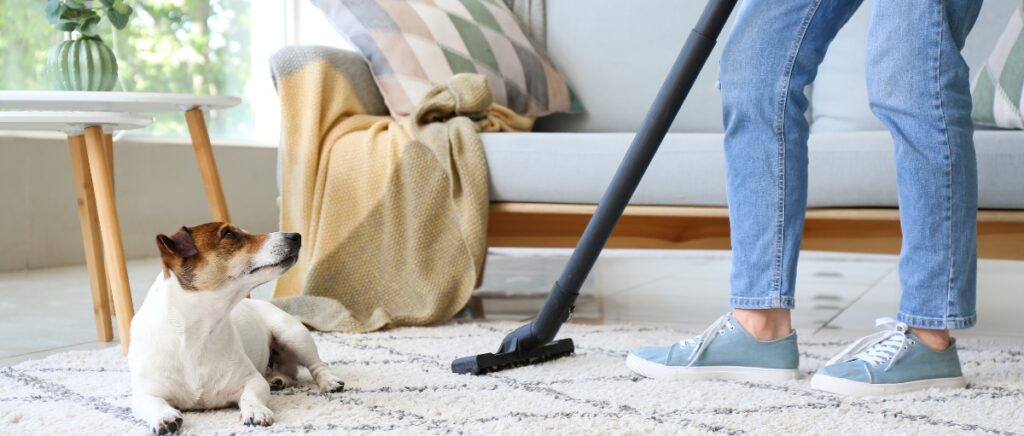Picture this: You’re enjoying a quiet evening at home when you notice your beloved pet scratching incessantly. Upon closer inspection, you spot tiny, jumping specks in their fur. Fleas!
Your heart sinks as you realize your home may be infested. You’re not alone—a staggering 95% of all flea infestations occur in the home environment.
Flea infestations are a common problem for pet owners, and they can quickly spiral out of control if not addressed promptly. These pesky parasites cause discomfort for your furry friends and pose health risks to pets and humans.
The good news is that with the right approach, you can effectively eliminate fleas and keep them from coming back.
Let’s discuss everything you need to know about getting rid of fleas in your home. From understanding the flea life cycle to treating your pets, living space, and yard, we’ve got you covered.
The Best Way to Get Rid of Fleas
The most common way to get rid of fleas involves a comprehensive, multi-pronged approach. This strategy combines treating your pets, home, and yard simultaneously for maximum effectiveness.
Start by applying veterinarian-recommended flea treatment to your pets, such as topical medications or oral tablets. Next, thoroughly vacuum your entire home, paying special attention to carpets, upholstery, and pet bedding, and immediately dispose of the vacuum contents in a sealed bag. Wash all bedding, including pet beds, in hot water.
Consider using a fogger or hiring a professional exterminator to treat your home for severe infestations. Remember to treat your yard as well, using pet-safe outdoor flea treatments. Consistency is key—repeat these steps every few weeks to break the flea life cycle.
This comprehensive method is the most effective and lasting solution for flea eradication because it attacks the problem from all angles.
Understanding Fleas
Understanding the enemy is essential to effectively combating a flea infestation in the house. Fleas are tiny, wingless insects that feed on the blood of mammals and birds. They are incredibly resilient and can quickly multiply, making them formidable foes.
The Flea Life Cycle
The flea life cycle consists of four stages:
- Egg: Adult fleas lay eggs on their host, which then fall off into the environment. A single female flea lays between 20-30 eggs per day.
- Larva: Flea eggs hatch into larvae, which feed on organic debris and adult flea feces in the environment. Larvae can survive for several weeks to several months.
- Pupa: After the larval stage, fleas spin a cocoon and enter the pupal stage. Pupae can remain dormant for months, waiting for the right conditions to emerge.
- Adult: When conditions are favorable, adult fleas emerge from their cocoons and seek out a host to feed on. Adult fleas can live for several months on a host.
Remember that flea eggs and larvae are just as important to consider as adult fleas when trying to get rid of them from your home. Understanding the four stages of the flea lifecycle is essential, as it will show you that a comprehensive approach is necessary to eliminate fleas effectively.
What Kills Fleas?
Several products and methods can effectively kill fleas. Common options include chemical insecticides (like fipronil or imidacloprid), natural remedies like diatomaceous earth or essential oils, and environmental treatments such as vacuuming and washing bedding in hot water. For the best results, a multi-pronged approach targeting the fleas and their environment is usually recommended.
Signs of a Flea Infestation
Knowing the signs of a flea infestation can help you take action quickly:
- Pets scratching, licking, or biting themselves excessively.
- Visible fleas or flea dirt (small black specks) on pets or bedding.
- Flea bites on humans, which appear as small, red, itchy bumps.
Health Risks Associated with Fleas
Fleas are more than just a nuisance; they can pose serious health risks:
- Allergic reactions: Some pets and humans may experience allergic reactions to flea bites, leading to severe itching, hair loss, and skin infections.
- Tapeworms: Fleas can carry tapeworm larvae, which can infect pets if they ingest an infected flea while grooming.
- Anemia: In severe infestations, particularly in young or small animals, blood loss from flea bites can lead to anemia, which can be life-threatening if left untreated.
By understanding the flea life cycle, recognizing the signs of an infestation, and being aware of the potential health risks, you can take proactive steps to protect your pets and your home from these persistent pests.
Treating Fleas on Pets
The first step in getting rid of fleas is to treat all pets in the household. Even if only one pet shows signs of an infestation, treating every furry family member is crucial to prevent re-infestation.
There are several effective treatment options available:
- Topical spot-on treatments: These are applied directly to the pet’s skin, usually between the shoulder blades, and provide long-lasting protection against fleas.
- Oral medications: Flea control pills are given to pets orally and work to kill adult fleas quickly.
- Flea collars: Collars impregnated with insecticides can help repel and kill fleas, but they may not be as effective as other treatments.
- Flea shampoos: Medicated shampoos can kill fleas on contact but do not provide long-term protection.
- Flea combs: These fine-toothed combs can help remove adult fleas, flea eggs, and flea dirt from your pet’s coat. While not a standalone solution, they are useful for monitoring flea activity and providing immediate relief to your pet.
In addition to these chemical treatments, there are also natural remedies that can be used for pet flea removal:
- Diatomaceous earth: This fine powder can be sprinkled on a pet’s coat to dehydrate and kill fleas.
- Neem oil: A natural insecticide, neem oil can be added to pet shampoos or applied directly to the skin to repel fleas.
- Citrus-based products: Citrus oils, such as lemon or orange, can create a flea-repelling spray for pets.
How to Get Rid of Fleas in the House
After treating your pets for fleas, it is important to clean your home thoroughly. Wash pet bedding and any human bedding in hot water, then vacuum your home, paying extra attention to carpets, upholstery, and crevices where fleas may hide. Dispose of the vacuum bag or empty the canister into an outdoor trash bin to prevent fleas from escaping back into your home.
For severe infestations, consider steam cleaning carpets and upholstery to kill fleas at all life stages.
Flea control products can also be used in the home:
- Flea sprays: These can be applied to carpets, upholstery, and pet bedding to kill fleas on contact.
- Foggers: Also known as bug bombs, foggers release a fine mist of insecticide into the air to kill fleas throughout the house.
- Boric acid powder: This low-toxicity powder can be sprinkled on carpets and vacuumed to remove fleas.
Natural remedies for indoor flea removal include:
- Diatomaceous earth: Sprinkling this powder on carpets and upholstery can help kill fleas by dehydrating them.
- Salt and baking soda: To kill fleas, a mixture of salt and baking soda can be sprinkled on carpets, left for several hours, and then vacuumed.
Treating Fleas in the Yard
Treating your outdoor spaces is important to prevent fleas from re-infesting your home. Start by maintaining your yard:
- Mow the lawn regularly to expose fleas to sunlight and heat, which can kill them.
- Remove leaf litter and debris, providing shaded, humid areas where fleas thrive.
Outdoor flea removal includes:
- Insecticide sprays: These can be applied to the lawn, shrubs, and other areas where pets spend time.
- Nematodes: These beneficial microscopic worms can be added to the soil to feed on flea larvae.
Natural remedies for outdoor flea treatment include:
- Diatomaceous earth: Sprinkling this powder around the yard can help kill fleas.
- Cedar wood chips: Spreading cedar chips in pet resting areas can help repel fleas.
Preventing Future Flea Infestations
Once you’ve successfully eliminated a flea infestation, it’s crucial to take steps to prevent future outbreaks:
- Use flea-preventive products on your pets year-round, even if you don’t see any signs of fleas.
- Maintain a clean home environment by regularly vacuuming and washing bedding.
- Monitor your pets for signs of re-infestation, such as excessive scratching or flea dirt.
When to Seek Professional Help for Flea Infestations
Sometimes, despite your best efforts, a flea infestation may feel overwhelming or out of control. If you’re struggling to manage the infestation on your own, or if your pets or family members are experiencing severe health issues related to fleas, it may be time to seek professional help.
Professional pest control services have the knowledge, experience, and tools to effectively eliminate even the most stubborn flea infestations. They can also help people prevent future outbreaks and maintain a flea-free home.
Your Path to a Flea-Free Home
Getting rid of fleas in your home requires a comprehensive approach that involves treating your pets, your living space, and your outdoor areas. By understanding the flea life cycle, using effective treatment methods, and preventing future infestations, you can successfully eliminate these pesky parasites and enjoy a flea-free home.
Remember, consistency and vigilance are key. Regularly monitoring your pets and home for signs of fleas and taking prompt action when needed will help keep these troublesome pests at bay.
With the right knowledge and tools, you can reclaim your home from fleas and provide a comfortable, healthy environment for your family and furry companions.
Sources
Frontline UK. (n.d.). Signs of a flea infestation. Retrieved from https://uk.frontline.com/pet-advice/signs-of-a-flea-infestation
FleaScience. (n.d.). How many eggs do fleas lay? Retrieved from https://fleascience.com/flea-encyclopedia/life-cycle-of-fleas/flea-eggs/how-many-eggs-do-fleas-lay/
CK Vets. (2018). Tapeworms and fleas go hand in hand. Retrieved from https://www.ckvets.com/news/ck-vets/tapeworms-and-fleas-go-hand-in-hand/











